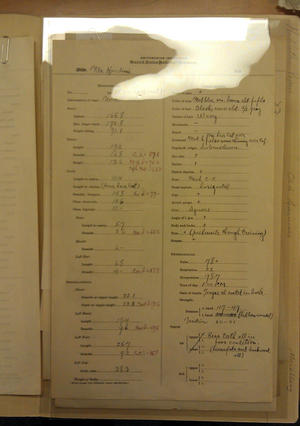This is the second in a series of two posts about Houdini at the Smithsonian. Read Part I here.
In December, I shared the story of how Harry Houdini escaped the Smithsonian—or at least prevented his brain from being collected by the Institution’s physical anthropologist Aleš Hrdlička. Houdini did allow himself to be measured by Hrdlička in 1926, however, and one reader asked for the resulting chart. We checked with the National Anthropological Archives, got the thumbs-up, and we’re happy to deliver it to you today.

It’s an interesting document. You’ll see that Hrdlička wrote “Mr. Houdini” in the field marked ‘tribe,’ which the anthropologist crossed out. Hrdlička had developed the form for measuring the indigenous peoples of North America. Its use for Houdini reflects the other side of anthropology in that era—the collection and study of data from members of anthropologists’ own society, or their society’s outskirts. Although Hrdlička was interested in Houdini as a fascinatingly accomplished American hero, other anthropologists used similar measurements to detail how generations of immigrants and Americans changed physically over time.
Next, you’ll see his age given as “52 (in April next).”
The measurements in centimeters follow. The left column is blurry, save for the numbers, so I’ll “translate”:
BODY:
- Stature … 165.8
- Max. finger reach … 172.8
- Height Sitting … 91.7
HEAD:
- Length … 19.2
- Breadth … 16.8 … c.d. = 87.5
- Height … 13.6 … M-H d. = 75.6 / ceph. Md = 16.53
FACE:
- Length to nasion … 11. 4
- Length to crinion … (some hair lost)
- Breadth, bizygom … 14. 8 Fac d.= 77.-
- Diam. Front min … 10.6
- Diam. Bigonial … 11.-
Nose:
- Length to nasion … 5.7
- Breadth … 3.6 … Nas. D = 63.2
Mouth:
Breadth … 6. –
Left Ear:
- Length … 6.8
- Breadth … 4.- Ear d. = 58.8
MISCELLANEOUS.
Chest:
- Breadth at nipple height … 32.1
- Depth at nipple height … 23.3. … Chest d. = 72.6
Left Hand:
- Length … 19.4
- Breadth … 9.6 … Hand d. 49.5
Left Foot:
- Length … 25.7
- Breadth … 9.2 Foot d. = 35.8
Left Leg:
- Girth, max. … 38.3
Weight of Body (with shoes, but without outer garments): … [Left blank].
The right-hand column should be clear enough for everyone to read, and is just as interesting for what Hrdlička didn’t include about Houdini as what he did. His blue-brown eyes, his thinning hairline, the poor condition of his rear teeth, and the facts that his left hand was wounded and his toes were prehensile—these all made the cut. He made no comment, however, on Houdini’s “Eye-slits,” “Lips,” the “Angle of l[ower] jaw,” or “Body and limbs.” The latter were physiological observables that the racially minded Hrdlička thought were germane for labeling peoples of indigenous descent—but not for Houdini, whose wear and tear as an escape artist made him interesting to Hrdlička.
What I’m getting at, is that this document reveals as much about Hrdlička as it does Houdini—what interested the anthropologist, when he cared to write about race, and when he cared to ignore it. It’s also worth noting that Hrdlička had initially planned to publish his measurements, but never did. Remember that Hrdlička had “determined” that there was nothing physically unusual about Houdini—he was just a disciplined and trained practitioner of his art. And if he wasn’t physically “unique,” then what was the point of measurement? Was it to slot Houdini into Hrdlicka’s collections of measurements of national or ethnic groups—or, as actually happened, to have the paper collected in his archives?
This isn’t to undercut this fascinating document, even as we share it. As a narrative historian, these sort of physical details have helped me bring past figures to life.
But let’s put it to the web: today, what do these measurements tell us about Houdini that we don’t already know? Had we not known that this was Houdini being measured, how useful would it be?
Produced by the Smithsonian Institution Archives. For copyright questions, please see the Terms of Use.

Leave a Comment